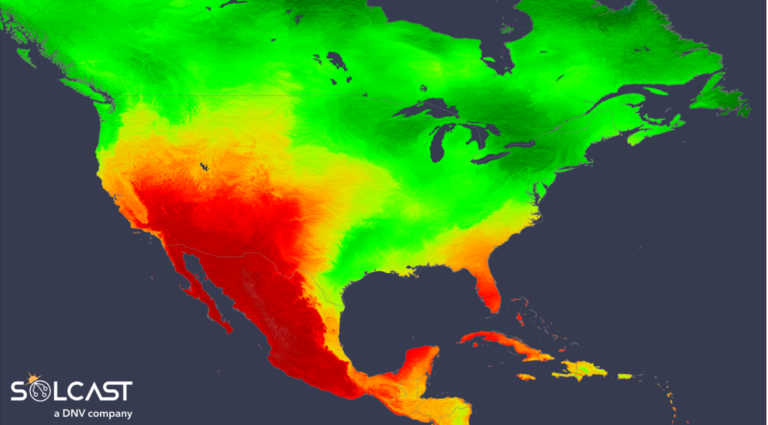In a new weekly update for pv magazineSolcast, a DNV company, reports that a significant high-pressure anomaly in the Pacific Ocean provided more stable conditions and pushed a deep layer of drier air over the western United States, resulting in clearer skies. While coastal areas experienced average to slightly higher than normal insolation, Midwestern states including Iowa, Nebraska, Kansas and Wyoming received up to 110% normal levels.
The irradiation patterns over North America in April 2024 were shifted by a high-pressure anomaly in the Pacific Ocean and drier air over the tropics, producing favorable irradiation results for large solar areas in the Southwest. Texas solar assets performed slightly below the long-term average as low-pressure systems and a tornado outbreak affected insolation at the end of the month.
Florida and parts of Mexico witnessed above-average solar radiation in April, benefiting from unusually dry tropical air masses. Solar radiation in Florida rose to 10% above the April average, while Mexico also saw a 5% increase. These areas tend to be the brightest places in North America in April, with long-term April averages of up to 7.7 kWh/day in Mexico and 6.6 kWh/day in Florida.
The increase in solar potential was associated with a wide band of below-average relative humidity in the tropics, which significantly reduced cloud cover and boosted photovoltaic production.
A significant high-pressure anomaly in the Pacific Ocean brought more settled conditions and pushed a deep layer of drier air over the western United States, resulting in clearer skies. While coastal areas experienced average to slightly higher than normal insolation, Midwestern states including Iowa, Nebraska, Kansas and Wyoming received up to 110% normal levels.

In contrast, Texas, the northeastern United States and parts of Canada experienced below-average solar radiation, mainly due to persistent low-pressure systems and storms. Texas saw radiation rates about 5% below standard, while New York state and neighboring Canadian areas recorded a 10% drop.
The unfavorable conditions, including above-average rainfall and cloud cover due to the heavy thunderstorms, significantly hampered PV generation. In addition, a severe weather outbreak in Texas from April 26 to 29 brought tornadoes and large hail, posing risks not only to irradiation but also to the physical integrity of PV installations and electricity transmission infrastructure.
Solcast produces these figures by tracking clouds and aerosols worldwide at a resolution of 1-2 km, using proprietary satellite data AI/ML algorithms. This data is used to drive irradiance models, allowing Solcast to calculate high-resolution irradiance, with a typical deviation of less than 2%, as well as cloud tracking predictions. This data is used by more than 300 companies that manage more than 150 GW of solar energy worldwide.
The views and opinions expressed in this article are those of the author and do not necessarily reflect those of the author pv magazine.
This content is copyrighted and may not be reused. If you would like to collaborate with us and reuse some of our content, please contact: editors@pv-magazine.com.


